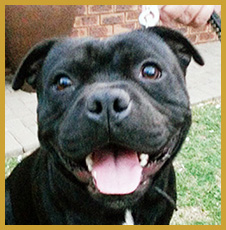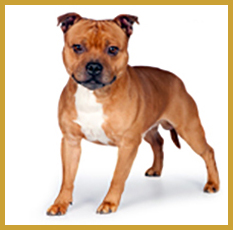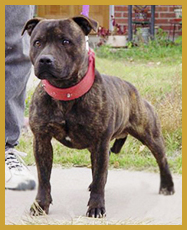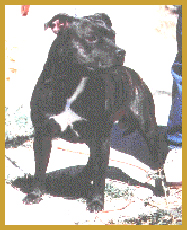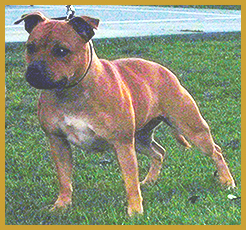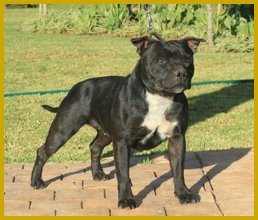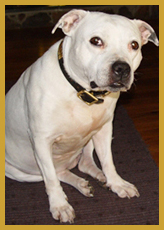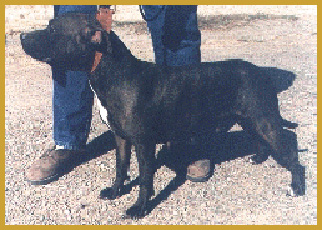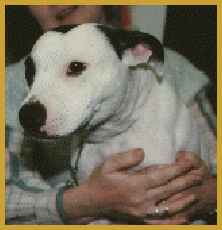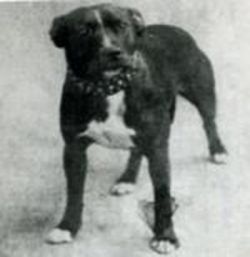R-LINE SYMPOSIUM ON-LINE
Participants: Linda Barker, Mary Cornelius, Craig Harrington, Paul Skelton, and Steve Stone on The Staffordshire Bull Terrier Forum.
Craig: Would someone care to answer CD Romaine's question, "What is the R-Line?"
Steve: You can find some material from Beilby's out-of print book on The Stafford Exchange at: http://www.staffordmall.com/staffordexchange.htm . Basically the R-Line consists of Staffords that have descended in direct tail-male line from an early dog named Ribchester Max, mostly through Bandits Brintiga. The M-Line, descending from Brindle Mick, enjoys numerical superiority, but all the other Lines have either fallen into obscurity or vanished completely.
Mary: It's great that another of the original lines is still out there and accessible. I was curious about the amount of inbreeding in the R-line, as I think I remember it being stated some months ago that the M-line was so inbred that there was going to be trouble up ahead if there wasn't some outcrossing.
Steve: I'd like to emphasize that at this moment there are plenty of typy, sound, and genetically "clean" M-Line dogs in all Stafford countries, but the increase in HD, PRA, CPS, and JC -- unknown in the Breed 30 years ago -- is a warning sign and an extremely alarming one, at that. M-Line breeders need to proceed with caution, and I'm sure that many are beginning to do so.
Mary: Today after our weekly hike in the forest with the dogs, Becky and I were viewing this neat scrapbook she has recently acquired. It contains all kinds of ads and articles from the turn of the century thru the 30' 40's 50's +. It shows several R line dogs, and early M-Line dogs. Very different in type among them. All in all, it was an interesting excursion into conformation, type and whatever hype the dogs had attached to them. Some of them (either lines) had conformation faults that we would not like today, but they were touted as champion, or successful proven studs, dead game on badgers etc. Some of them looked quite similar to the show Stafford we recognize today, others quite a bit more like Staffords on stilts, some with rather long noses and odd shaped heads etc. One thing that I saw all had in common was much larger, softer looking ears. The sizes ranged as much then as they do today....if not more. Really fun stuff to study.
Seriously, though, It seems to me that the M-Line has branched out enough so that it is not really in that much danger at this point.
Steve: Yes, the M-Line has branched out numerically, but the numbers don't really address the problem because numbers do nothing to increase genetic diversity. The numbers only SEEM to "spread the risk."
Two kinds of M-Line inbreeding have been taking place: 1) Every line in the pedigree goes back to Brindle Mick, and in many specimens that means more than 64 lines 2) inbreeding within the two or three most recent generations, often to stock that is itself unwisely inbred and almost always without any culling.
Mary: But isn't the R-line is numereically much smaller and doesn't it have a lot more up-close inbreeding?
Steve; Yes, the R-Line is numerically smaller, which makes it easier to keep track of. As I said, most R-Line descendants come down from Bandits Brintiga, and there has indeed been considerable inbreeding in the R-Line, too, as well as some outcrossing to the M-Line, so the R-Line should be considered a "comfortable" rather that a "complete" outcross. (Actually, a complete outcross was never possible after the original Bulldog and Terrier crosses.)
Mary: How does [outcrossing] this help....or hinder?
Steve: It helps two ways: 1) fostering hybrid vigor with its many benefits such as increased fertility and longevity 2) providing a way to avoid excessive inbreeding.
It may hinder in two ways: 1) if the two crossed strains are somewhat dissimilar in phenotype, causing a diminishment of type (within the Standard) in a hihgly-bred strain 2) tending to reduce the genetic prepotency of resulting offspring.
In the next ten to fifteen years even the carefully bred and culled M-Line dogs will begin needing outcross blood to maintain the vigor and vitality of the original Stafford stock. The only source of outcross blood is the R-Line. But unless the best R-Line stock were every bit as good as the best M-Line stock (which seems to be the case today) it would be useless.
Mary: It would be interesting to be able to start looking at the DNA on some of our dogs.
Linda: As for the DNA testing, I'm bringing King as well as one of the male pups from my last litter to Seattle for the Specialty weekend and intend to have them DNA'ed by the AKC.
Mary: That's great, Linda. I, too, am interested in the DNA for my linebred dog and bitch and their outcross mother. I wasn't sure how the DNA was going to be used. Is this something that AKC is going to use somehow in a data base for their own studies, or are the owners getting access (and interpretation) to the results?
Linda: The owners will get access to the results. Interpretation? I don't know.
Mary: What about mixing and and matching phenotypesfrom these different lines?
Steve: Because Staffords at shows are judged without reference to Lines, the cumulative result is that the best R-Line stock and the best M-Line stock cannot be distinguished from each other on the basis of Line, that is, on the basis of the phenotype. So, the R-Line and the M-Line phenotype are practically identical although their genotypes differ. Each Line has its Good, Better, and Best specimens.
Today's show-ring Staffords are much more uniform in phenotype than 30 years ago but are much more prone to hereditary (genotype) disorders such as HD, PRA, and CPS due to wise and unwise inbreeding coupled with a nearly complete lack of sensible culling.
Perhaps two or three percent of all Staffords ever whelped see the inside of a show ring and that many of the best spend their entire lives at home with the family (where they belong).
Paul: Aren't all Staffords the product of inbreeding at some distant point? How can we have a true outcross from initially inbred stock? Don't all of the lines descend from the same original stock?
Steve: At the time of the original Bulldog and Terrier cross, the Bulldog had probably endured considerable inbreeding over the preceding two hundred years while the Terrier was probably less inbred. So the original Bull-and-Terrier cross was a total outcross. When the first Staffords were KC registered a hundred and twenty years later, the pedigrees of most dogs could not be verified beyond a couple of generations, so we have no way of knowing what degree of inbreeding, if any, was involved. But any inbreeding that did take place must have been for retaining gameness rather than for conformation.
Paul: For outcrossing, don't we need to take the best possible specimens having the most inbreeding of the R and M lines?
Steve: Yes. Those specimens need outcrossing the most and will make for the greatest possible hybrid vigor in the offspring.
Paul: Don't the last 3 or 4 generations that statistically indicate the CoI?
Steve: Yes, but we're not talking statistics here but real dogs that live with real flesh-and-blood people.
Paul: If there were no originally genetically defective Staffords [30 years ago], where did the HD and other genetic defects come from? Can you breed in something that does not exist genetically to begin with? As an analogy, can we have blue eyed or bi-eyed Staffords if it is not somewhere in the genetic makeup?
Steve: In Staffords as in most breeds, the highly desirable traits are dominant and the undesirable ones are recessive. Inbreeding brings out hidden deleterious recesssive characteristics which, if not culled, begin to spread through the Breed. Once a recessive, such as Hd, appears it is difficult to get rid of.
Paul: I think that is the reason that we are all here [on the Forum] and attempting to understand and utilize the information that we are sharing. I, personally, have a three-generation plan that cannot be implemented for another 8-12 months with inbred M-Line dogs. Only time will tell if they are worth breeding. If they are not in my, and others more knowledgeable, opinion, I will have them neutered and enjoy the hell out of them for the rest of their lives. At least that is my plan, and we all know that the "best plans of mice and men" etc. etc...
Linda's: Since in my house I have some VERY tightly bred, double- R-Line bred dogs and bitches, I can tell you right now that my next litter from my only breedable bitch will be an outcross; I just need to decide what dog to use over her.
The male from her litter will be judiciously used over R-Line bitches other than my own as well as outcrossed to see how prepotent he is as a stud dog. Since he's tightly bred, he should be very potent, but only time will tell. This male is King; the one Craig was talking about.
